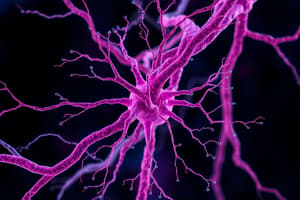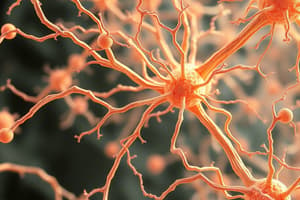Podcast
Questions and Answers
What is the role of the initiator proteins in the S Phase of cell division?
What is the role of the initiator proteins in the S Phase of cell division?
- They separate chromosomes during mitosis.
- They signal kinetochores for microtubule addition.
- They load into origins and bind to them. (correct)
- They break down the nuclear envelope.
Which microtubule type is associated with attaching to chromosomes during mitosis?
Which microtubule type is associated with attaching to chromosomes during mitosis?
- Kinetochore microtubules (correct)
- Cytoplasmic microtubules
- Astral microtubules
- Interpolar microtubules
What occurs when chromatids are bound to different centrosomes during alignment?
What occurs when chromatids are bound to different centrosomes during alignment?
- Low tension leads to increased microtubule bonding.
- High tension signals the addition of microtubules. (correct)
- Low tension leads to rapid chromosomal separation.
- High tension signals microtubule disassembly.
During chromosomal separation, what drives the initial movement towards centrosomes?
During chromosomal separation, what drives the initial movement towards centrosomes?
How does cytokinesis occur in a dividing cell?
How does cytokinesis occur in a dividing cell?
What role does the cytoskeleton play in cellular structure?
What role does the cytoskeleton play in cellular structure?
Which of the following statements accurately describes microtubules?
Which of the following statements accurately describes microtubules?
What is the primary function of motor proteins in the cytoskeleton?
What is the primary function of motor proteins in the cytoskeleton?
What does 'treadmilling' in the context of filament dynamics refer to?
What does 'treadmilling' in the context of filament dynamics refer to?
How do capping proteins influence filament dynamics?
How do capping proteins influence filament dynamics?
What is the significance of the GTP cap in microtubules?
What is the significance of the GTP cap in microtubules?
Which protein complex is responsible for producing branched actin networks?
Which protein complex is responsible for producing branched actin networks?
Calcium ions regulate muscle contraction primarily by affecting which protein?
Calcium ions regulate muscle contraction primarily by affecting which protein?
Which type of cell junction is formed by cadherin clusters?
Which type of cell junction is formed by cadherin clusters?
What role do integrins play in cell adhesion?
What role do integrins play in cell adhesion?
What triggers the contraction in skeletal muscle fibers?
What triggers the contraction in skeletal muscle fibers?
Which of the following describes the behavior of intermediate filaments?
Which of the following describes the behavior of intermediate filaments?
What constitutes the axoneme of cilia and flagella?
What constitutes the axoneme of cilia and flagella?
Flashcards
S Phase DNA Replication
S Phase DNA Replication
The stage in the cell cycle where the entire genome is copied.
Spindle Formation
Spindle Formation
The process of creating the structure that separates chromosomes during cell division, made of microtubules and motor proteins.
Kinetochore
Kinetochore
The protein structure on chromosomes that connects to microtubules, enabling chromosome movement.
Chromosomal Attachment
Chromosomal Attachment
Signup and view all the flashcards
Tension and Alignment
Tension and Alignment
Signup and view all the flashcards
Cytoskeleton Scaffolding
Cytoskeleton Scaffolding
Signup and view all the flashcards
Intracellular Transport
Intracellular Transport
Signup and view all the flashcards
Force Generation
Force Generation
Signup and view all the flashcards
Cell Division
Cell Division
Signup and view all the flashcards
Actin Filaments
Actin Filaments
Signup and view all the flashcards
Microtubules
Microtubules
Signup and view all the flashcards
Intermediate Filaments
Intermediate Filaments
Signup and view all the flashcards
Polymerization
Polymerization
Signup and view all the flashcards
Treadmilling
Treadmilling
Signup and view all the flashcards
Microtubule Organizing Centers
Microtubule Organizing Centers
Signup and view all the flashcards
Critical Concentration
Critical Concentration
Signup and view all the flashcards
ATP/GTP Hydrolysis
ATP/GTP Hydrolysis
Signup and view all the flashcards
GTP Cap
GTP Cap
Signup and view all the flashcards
Motor Proteins
Motor Proteins
Signup and view all the flashcards
Kinesin
Kinesin
Signup and view all the flashcards
Regulation of Filament Formation
Regulation of Filament Formation
Signup and view all the flashcards
Study Notes
Cytoskeleton Major Functions
- Gives structure and support to cytoskeleton
- Helps organize inside cell
- Resists forces
- Network of tracks for organelle transport
- Cell contraction
- Cell movement and migration
- Beating of the cilia
- Separation of chromosomes
- Splitting parents into daughter cells during cytokinesis
3 Types of Filaments
Actin
- Plasma membrane
- Shorter and smaller than other filaments
- Drives contraction movements (like muscle)
- Binds and hydrolyzes ATP
- 2 protofilaments
- Polarized
Microtubules
- Emanating out of a centrosome
- Building blocks are alpha and beta tubules
- Cytoplasm and nucleus
- Flexible ropes resistant to stretching
- Non-polarized
- 8 tetramers form filaments
- Has lamins that organize nuclear pores and structure
- Can bind with ATP or GTP
- Formed from smaller subunits through noncovalent interactions
Intermediate Filaments
- Not discussed in detail.
Filaments: Formation and Subunits
- Protofilaments stabilize interior filaments
- Protofilaments are asymmetric and polarized (Beta at the end and Alpha at the beginning, moving upwards)
Elongation and Treadmilling
- Adding more than removing
- Add to one end and remove at the other end
- Staying the same length
- Occurs when one end is largely ADP/GDP bound and the other is largely ATP/GTP bound
Microtubule Organizing Centers (MTOCs)
- Nucleation occurs here
- Polymerization of microtubules depends on nucleation and elongation
- Beta combines GTP and hydrolyzes it into GDP
Concentrations
- Each end of a filament has a different critical concentration
- Critical concentration = rate of adding and subtracting subunits equal
- If subunit concentration exceeds critical concentration, growth occurs
- If below, disassembly occurs
- Filament formation and concentration of free subunits influence association (Kon) and dissociation (Koff) rates
- Plus end is more stable than the minus end
ATP/GTP Hydrolysis
- Controls the concentrations
- Beta binds GTP then to GDP to become a different form (D)
- Hydrolysis causes conformational changes that decrease filament affinity
- D forms are more likely to dissociate, T forms are more likely to be added
GTP Cap
- Creates a cap on plus end - making it straight and stable
- Prevents microtubule curvature that GDP subunits would have - keeping the shape round.
- Catastrophe occurs when the cap is lost.
Motor Proteins
- Convert chemical energy into mechanical energy
- Have heads that bind to filaments and tails that bind to cargo
- Binds to hydrolyze ATP
- Carries organelles to destinations
- Causes sliding of filaments
Motor Protein Types
- Myosin = actin dependent
- Kinesin = microtubule dependent, usually plus end directed
- Dynein = microtubule dependent, usually minus end directed
- Velocity = rate of physical displacement
- Processivity = how long a motor protein stays active with a filament
Regulation of Filament Formation and Polymerization
- Affected by proteins that bind free subunits
- Proteins bind monomers and expose only the plus end binding side of actin monomer, promoting plus end assembly
ARP 2/3
- Produces branched actin networks
- Acts at minus end as nucleators
Formin
- Functions at plus end of filament
- Linear, unbranched actin filaments
Thymosin
- Binds subunits to prevent assembly
Prolifin
- Binds subunits and speeds up elongation to add filaments
Regulation of Filament After Formation
- Cofilin
- Destabilizes bound actin filaments
- Induces a twist that loosens subunits
- Binds to ADP actin to promote turnover of older filaments
Capping Proteins
- Stabilizes filaments
- Prevents ATP/GTP hydrolysis
- Capped on plus end after growth
Skeletal Muscles
- Made of myofibrils
- Myofibrils are made of sarcomeres
- Actin outside Z disk, myosin between
- Actin and anchoring stabilizer by capping proteins
- Nebulin binds actin
- Actin binding proteins stabilize filament
- Stays actin bound for short periods.
Sarcomere and Accessory Proteins
- Actin filaments anchor and stabilize by capping proteins
- Nebulin binds actin
- Stays actin bound for brief periods
- Actin-binding proteins stabilize filaments
Sliding Model
- Calcium is released, binds to troponin
- Moves tropomyosin, myosin connects to actin
- Myosin heads hydrolyze ATP, actin slides
- Myosin head binds to ATP and detaches from actin
Calcium Regulates Contraction
- Regulates position of tropomyosin in actin B
- By binding to move it out of the way
Flagella and Cilia
- Can propel cells through liquid media
- Flagella is long filaments causing wave movement
- Cilia are short filaments causing swimming power and recovery stroke
Axoneme
- Inside of flagella and cilia
- Connected in a circle
- Activation of dynein, motor protein arms reach and attach to neighbor and tries to walk/slide, cross-linking proteins stop gliding.
Basal Bodies
- Anchors flagella and cilia
ECM
- Network of secreted proteins and polysaccharides, forms solid substrate for cell anchoring and crawling.
- Glue that holds cells together
Collagen
- Trimers, rod-like triple helix
- Rigid fibrils, pack into thick filters
- Resistant to pulling forces
Proteoglycans
- Assembled into large complexes from core linkage
- Has complex carbohydrates
Fibronectin
- 2 polypeptides linked by disulfide bridges
- Binding sites for ECM proteins, receptors, brings together components
Laminin
- 3 Polypeptides linked by disulfide bonds
- Binds to cell surface adhesion receptors and other ECM components.
Integrins (Mediate cell-ECM attachment)
- Occurs at ECM binding sites and hemidesmosomes
- Capable of inside-out signaling (active and inactive)
- Outside-in signaling (affects cell differentiation)
Focal Adhesions
- Sites that anchor cells to substratum (ECM)
- Large clusters of integrins
- Signaling hub
- Capable of creating and responding to mechanical forces
Hemidesmosomes
- Anchor basal surface of epithelial cells to basement membrane, large clusters of integrins.
- Signaling hub
- Resist forces
- Intermediate filaments
Cadherins
- Require Ca++ for binding
- Mediate cell-cell interactions
- Catentin tethers cadherins to the cytoskeleton
Cell-Cell Anchoring Junctions
- Adherens junctions
Desmosomes
- Links intermediate filaments
Tight Junctions
- In epithelial tissues forming an impermeable barrier
- Limits lateral diffusion within the plasma membrane
- Claudins and occludins
Gap Junctions
- Allows passage of small molecules
- Link cell cytoplasms
- Connexins proteins assemble to form transcellular pores
Adhesion and Traction
- Protrusion is when cell extends membrane and attaches to substratum
- Bundles of actin and myosin contract and squeeze cell forward
- Adhesion on back breaks
FIllipodia and Lamellipodia
- Filopodia: Spike out of plasma membrane, tight bundle of unbranched actin filaments.
- Lamellipodia: ARP 3 nucleates actin at leading edge. Branched network leads to a broad flat membrane extension.
Cell Cycle
- Cells duplicate genome and divide to create more cells.
- When do cells divide? A buildup of factors hits a threshold, signaling health of the cell.
- S Phase: Replication of entire genome; starts at origin of hundreds of different located genomes.
M-phase (Mitosis)
- Spindle formation Microtubules and motor proteins Made from 2 centrosomes Separates chromosomes Astral microtubules contact cell cortex from centrosome Interpolar microtubules connect centrosomes Kinetochore attaches to chromosomes for movement.
- Chromosomal Attachment and Tension Nuclear envelope breaks down Kinetochores on chromosomes mediate attachment to microtubules Can subtract or add subunits. Kinetochore signals to loosen/tighten bonds, depending on tension levels between chromatids.
- Chromosomal Separation Microtubule disassembly and motor proteins, movement toward centrosomes Curvature of disassembly of microtubules, slides collar Strengthening dynein pulls of centrosomes toward cortex.
- Cytokinesis Occurs through actomyosin contraction, membrane insertion Microtubule spindle signals where contraction will occur. Two sister chromatids pulled in opposite directions.
Studying That Suits You
Use AI to generate personalized quizzes and flashcards to suit your learning preferences.




